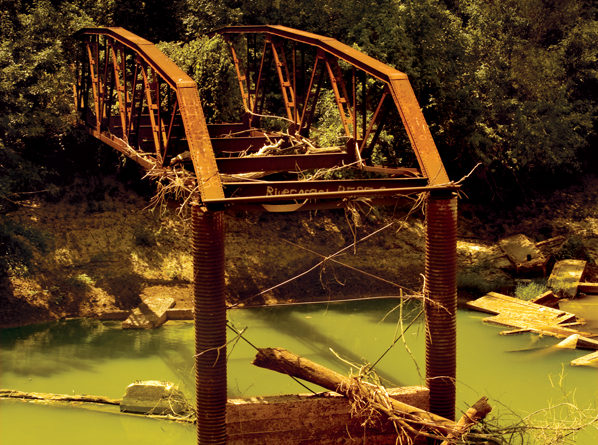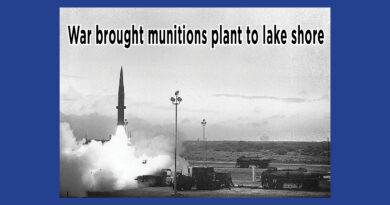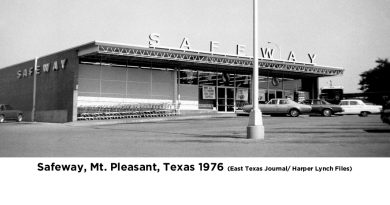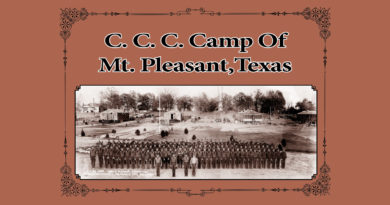Old Iron Bridge

By Sam Ferguson
I’ve heard yarns of an old iron bridge over the Sulphur River northeast of Talco. With an adventurous spirit, my friend Debbie and I set out to find it.
Heading out of Mt. Pleasant we drove north on the Greenhill Road (FM 2152) named for E.H. Green, an early pastor of the Presbyterian Church built at Greenhill in 1860 alongside the 33-mile road to Clarksville.
About ten miles out, state maintenance now ends where the road drops into White Oak Creek bottom.
The road is shown as established prior the printing of an 1845 Texas State map, the year the Republic joined the Union. Its original route was laid out by Andrew Jackson Titus, who opened the road and the first stage line passing through Mt. Pleasant and connecting the Red River near Clarksville to Jefferson.
Born in Tennessee, this was still Mexico when he arrived.

Red River County Commissioner Wayne Johnson, right, along with volunteers Dennis Ewing and Terry Simmons has been working to keep open the Clarksville to Mt. Pleasant segment of a stage coach route opened by Andrew Jackson Titus.
“A.J. Titus fought in the Texas Revolution of 1836 before settling 12 miles east of Clarksville where he opened a post office and established a farm,” wrote my Great Uncle Richard Loyall Jurney in his “History of Titus County, Texas, 1846 to 1960.”
A successful Jefferson merchant, in 1855 Perryman T. Black came to Titus County, settled and built a toll bridge over White Oak. The road from Mt. Pleasant to Clarksville came then to be called Black’s Bridge Road, historian Traylor Russell wrote in his “History of Titus County.”
Now, it’s Titus County Road 1905 from White Oak to the Red River County line at the Sulphur River.
Slowing on the county road, we took our time passing the July cutting of hay still sitting in a meadow, country places with kitchen gardens beginning to blister in the heat and cattle taking mid-day sanctuary in the shade of mammoth oaks.
There was an oil pump jack in a backyard that looked like a modern art exhibit of an iron horse in a stance.
The all-weather oil top road surface ends 15 miles out of town, where the road crosses Highway 71.
In the ditch we spotted a sawhorse with the sign “No Through Traffic.” Ignoring it, I was glad we were in a jeep. I wasn’t sure if we were on a county road or a private drive. A thousand feet on, the dirt road had fresh crumbed clumps of dirt, clay, rock and old pieces of oil top graded flat.
We passed a burned-out husk of a truck laying dormant on the roadside.
The hardwood forest canopy shaded sunlight. The last fall leaves blackened the roadsides and an occasional dwarf palmetto palm glowed green on the floor of bottomland woods inspiring thoughts of enchanted forests in folklore.
At the Sulphur River, where we’d hoped to find a remnant of the Old Iron Bridge, we stopped on a modern concrete bridge, its railings teaming with the graffiti work of untrained artists, declarations of love, hate and peace.
‘We’ve got a million dollar bridge if we could only get to it,’ Terry Simmons remembers someone saying. A whipcord lean length of shirtless longhaired free spirit, Mr. Simmons had come cruising in from Cuthand way on his four-wheeler. We met him at the river.
The latest bridge was built with Texas Department of Transportation (TxDOT) money back in 1994, he said, back when TxDOT still had on its books plans to build a state-maintained Farm Road.
Plans change.
“We’re looking for the Old Iron Bridge,” I said.
“You just missed the turnoff,” Mr. Simmons said, “right back up the road on the Titus County side.”
When still in use, the Old Iron Bridge was last inspected by the state in 1990. Also known as “The Meadows Curve Bridge,” it was 144 feet in length. It was one lane, 11.5 feet wide. The deck was in fair shape, the structure poor to satisfactory. Average daily traffic was 60.
Mr. Simmons said he owned a hundred acres near Cuthand. He said he’d been there since 1971 and that he and another friend had volunteered to help Red River County Commissioner Wayne Johnson work to keep the road passable.
Dennis Ewing, an oilfield worker, rounds out the volunteer workforce, that’s crossed over to the Titus County side steadily working toward the barricade Debbie and I saw in the ditch after crossing Highway 71.
“These guys are using their own equipment and we’re all working on our own time,” said Commissioner Johnson, who had arrived in a pickup with a bed full of tools.
There was a time when keeping the road in shape was more pressing.
In the March 18, 1854 issue of The Northern Standard, Clarksville Publisher Charles DeMorse described striking out during spring floods to pick up mail that hadn’t come from Mt. Pleasant in four days.
“On arriving at McCroy’s crossing on Sulphur River, we engaged Mr. McCroy as our pilot before swimming the river (on horseback),” he reported. “It required a roundabout course of two days travel to overcome 31 miles.
“Plunging into the forest, we encountered a vast sea, the limits of which were beyond sight in the trees that looked like tall slim spars emerging from some great depth. We knew that our guide knew the bottom as well when it is underwater as when dry and as he said he did not believe we would have to swim much, we went on in good heart.
“We crossed White Oak the next morning, which was also overflown, and there we met the mail rider who had not yet gotten here.”
In 1866, the Sulphur Bridge and Turnpike Company was granted authority to collect tolls ranging from 5 cents for loose stock to $1.50 for a wagon pulled by four horses passing over a proposed bridge.
The Cuthand volunteer road crew said that for any of the 40 or so residents of Cuthand, the road is the quickest route to Talco.
The roadwork of this crew brings to mind the history written by Traylor Russell. The first roads were trails cut through the woods and the only function that a road served the early settlers in Titus County was either to go to the county seat to transact legal business or to other towns to sell their produce and buy supplies. Prior to 1846, Clarksville was the county seat of Red River County which Titus County today was part of. Up until 1912 or 1915 when automobiles needed a different kind of road and before counties started voting in bonds and levying taxes to build roads, all men between the ages of 18 and 45 were summoned to contribute ten days a year to roadwork and were required to bring tools to work with. These occasions of working the road were rather festive times in any community and were always looked forward to for they could meet and exchange ideas.
We found the Old Iron Bridge where Mr. Simmons directed us. Built in 1930, it brought to mind traveling on family vacations in the 70’s, when I was still young enough to be awed riding over a river beneath steel trusses holding up a bridge.
I still am, maybe more by the greater aesthetic awareness of a thing like that passing from use.
I got out my camera.






When I was kid growing up in Talco, friends and I would camp out on Sulphur River
frequently. Many of those times was near the Old Iron Bridge.
We swam, fished, hunted, and just about anything you could think of.
I remember one time there was big ol’ log jam under the bridge.
Being “Ten Foot Tall and Bullet Proof” not knowing the meaning of Dangerous,
we would work one of those big ol’ logs free and ride it down the river.
Trek back through the woods and do it again. Those were the days memories were made.